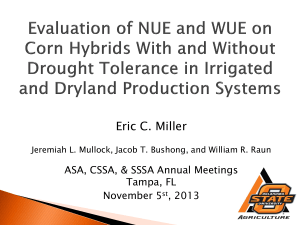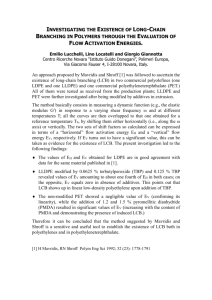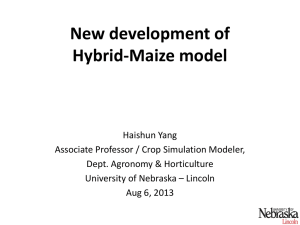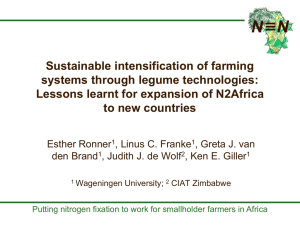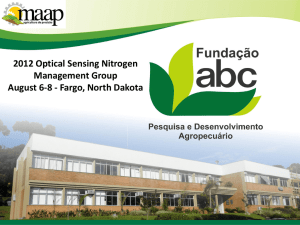Effect of Seed Distribution and Population on Maize Grain Yield
advertisement
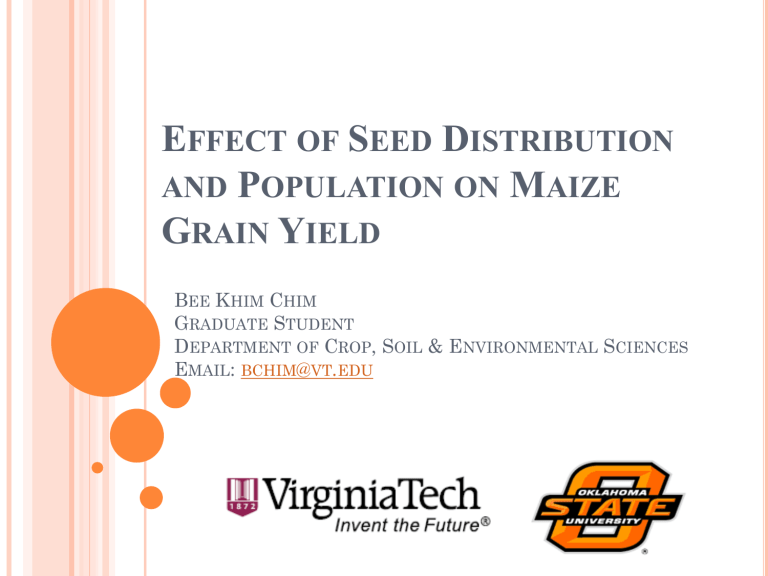
EFFECT OF SEED DISTRIBUTION AND POPULATION ON MAIZE GRAIN YIELD BEE KHIM CHIM GRADUATE STUDENT DEPARTMENT OF CROP, SOIL & ENVIRONMENTAL SCIENCES EMAIL: BCHIM@VT.EDU INTRODUCTION Production of maize in World, U.S.A and Sub Saharan Africa. World United States of America Sub Saharan Africa 7, 045, 483, 640* 314, 572, 078* 874, 841, 049† Production (Mt) 840, 308, 214‡ 327, 879, 500‡ 63, 580, 236‡ Area Harvested (Ha) 161, 765, 388‡ 34, 163, 300‡ 30, 910, 018‡ Yield (Mt/Ha) 5.20 9.60 2.06 Population * From United States Census, 2012 † From World Bank, 2011 ‡ From www.faostat.org , 2010 INTRODUCTION (CONT’D) Developed Countries, maize planting Developing Countries, maize planting http://www.ia.nrcs.usda.gov/technical/JensenPhotos.html http://nue.okstate.edu/Hand_Planter/img21.jpg INTRODUCTION (CONT’D) Maize area, ha (FAOSTAT, 2010) Total Sub Saharan Africa Planted by hand (60%) * ha 161, 765, 388 ha 30, 910, 018 ha 18, 546, 011 Potential yield increase (25%)* (single seeds 14-17 cm apart) 15, 895, 059 Mg Yield increase of 25% for 60% hand planted maize worth more than 4.6 billion dollars/ year (corn price at $ 0.295/kg) *From(http://nue.okstate.edu/Hand_Planter/summary_AGCO1.pdf ) LITERATURE REVIEW Plant Spacing • Narrow: tall and weak steam plants, decreased yield due to lodging (Rowland, 1993; Futuless et. al, 2010) Wider: Encourage weed and pests infestation, influences maize yield (Whiteman, 1981) Increased row spacing from 0.35 to 1m will decrease grain yield (Riahinia and Dehdashti, 2008) • • Light Interception • Development of crop growth related to light interception (Gardner et al., 1985) Optimization of light interception increased grain yield (Stewart et al., 2003) Light interception can be increased by reduced row spacing (Andrade et al., 2002) • • OBJECTIVE To determine the value of equadistant plant spacing when compared to “hills”, placing 2-3 seeds per hill MATERIALS AND METHODS Locations: Lake Carl Blackwell research station and Efaw research station Cropping year: Summer 2011 and Summer 2012 10 treatments with 3 replications arranged in RCBD, middle two rows planted by hand Preplant N rate: 395.2 kg N ha-1 applied in the form of urea (46-0-0) Light Interception, LI-COR MATERIALS AND METHODS (CONT’D) Treatment structure Treatment Seeds Hill-1 Distance Between Hills Estimated Plant Population m Plants ha-1 1 1 0.16 81,984 2 2 0.16 163,968 3 3 0.16 245,952 4 1 0.32 40,992 5 2 0.32 81,984 6 3 0.32 122,976 7 1 0.48 27,328 8 2 0.48 54,656 9 3 0.48 81,984 10 (Twin row) 0.32 81,984 MATERIALS AND METHODS (CONT’D) Grain Yield, 2011 RESULTS 3500 SEDEFAW=638 3000 Grain Yield, kg ha-1 Grain yield versus seeds/hill in Lake Carl Blackwell and Efaw research station, Oklahoma, 2011-2012. 2500 0.16m EFAW 2000 0.32m EFAW 0.48m EFAW SEDLCB=248 1500 0.16m LCB 1000 0.32m LCB 500 0.48m LCB 0 Grain Yield, 2012 1 2 Seeds per 14000 SEDEFAW=1327 Grain Yield, kg ha-1 12000 10000 0.16m EFAW 8000 0.32m EFAW 6000 0.48m EFAW SEDLCB=1023 4000 0.16m LCB 0.32m LCB 2000 0.48m LCB 0 1 2 Seeds per 3 hill-1 3 hill-1 IPAR, 2011 RESULTS SEDEFAW=8 100,0 SEDLCB=7 90,0 80,0 Intercepted photosynthetically active radiation (IPAR) between treatments in Lake Carl Blackwell and Efaw research station, Oklahoma, 2011-2012. IPAR, % 70,0 60,0 50,0 IPAR LCB 40,0 IPAR EFAW 30,0 20,0 10,0 0,0 1 2 3 4 5 6 Treatments IPAR, 2012 SEDLCB=5 80,0 SEDEFAW=6 70,0 IPAR, % 60,0 50,0 40,0 IPAR LCB 30,0 IPAR EFAW 20,0 10,0 0,0 1 2 3 4 5 6 Treatments 7 8 9 10 7 8 9 10 2011 3500 RESULTS y = -36,535x + 4384,7 R² = 0,2832 Intercepted photosynthetically active radiation (IPAR) between treatments in Lake Carl Blackwell and Efaw research station, Oklahoma, 2011-2012. Grain Yield, kg ha-1 3000 2500 2000 1500 1000 500 0 0,0 20,0 40,0 60,0 IPAR, % 2012 14000 y = 222,44x - 2090,8 R² = 0,7629 Grain Yield, kg ha-1 12000 10000 8000 6000 4000 2000 0 0,0 10,0 20,0 30,0 40,0 IPAR, % 50,0 60,0 70,0 80,0 80,0 100,0 POSSIBLE FACTORS????? Arghh!!!!! WEATHER Total monthly rainfalls (mm), surface air temperature (°C) in Lake Carl Blackwell and Efaw research station, Oklahoma, 2011-2012. 14 35 12 30 10 25 8 20 6 15 4 10 2 5 0 0 April 18 16 14 12 10 8 6 4 2 0 35 30 25 20 15 10 5 0 April May June July August Month LCB (Rainfall) LCB (Temp) June July August Month Stillwater (Rainfall) Stillwater (Temp) Temperature, °C Rainfall, mm Year 2012 May LCB (Rainfall) Stillwater (Rainfall) LCB (Temp) Stillwater (Temp) Temperature, °C Rainfall, mm Year 2011 CONCLUSION Trend for decreasing yields with increasing number of seeds per hill (same population) range (200 to 1000 kg/ha) except Efaw research station, 2012. Trend for decreasing IPAR with increasing number of seeds per hill (same population) range ( 6 to 17%) except Efaw research station, 2012 IPAR was correlated with final grain yield. Excessive heat lowered yield levels and decreased the ability to decipher treatment differences CURRENT AND FUTURE RESEARCH http://nue.okstate.edu/Hand_Planter.htm ACKNOWLEDGEMENT Advisor at OSU: Dr. Bill Raun Advisor at VT: Dr. Wade Thomason Soil fertility Graduate students at Oklahoma State University( Jeremiah Mullock, Emily Rutto, Guilherme Torres, Jacob Bushong, Sulochana Dhital, Natasha Macnack, Candibyani Fnu, Alex Cumbie, Michael Reinert, etc. ) Thank you so much for your attention~!!!
